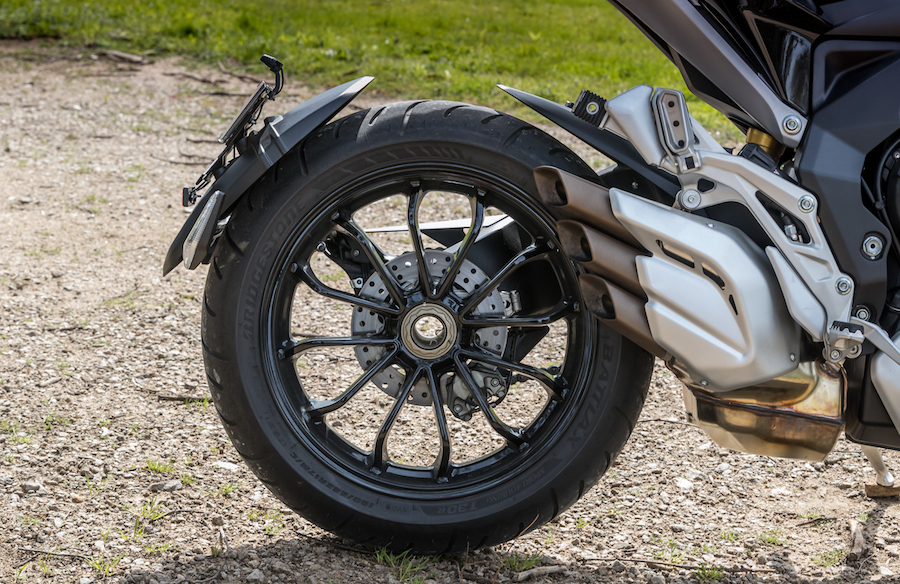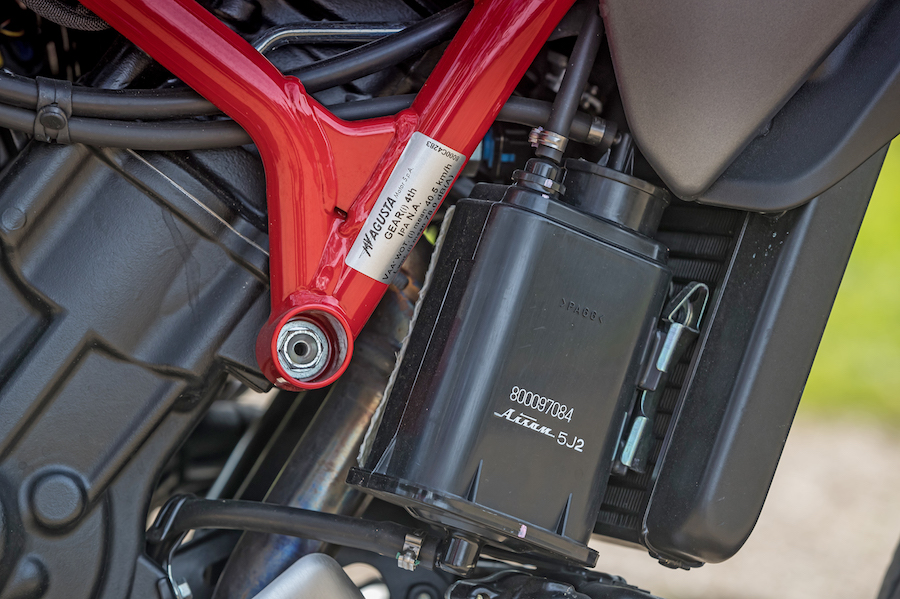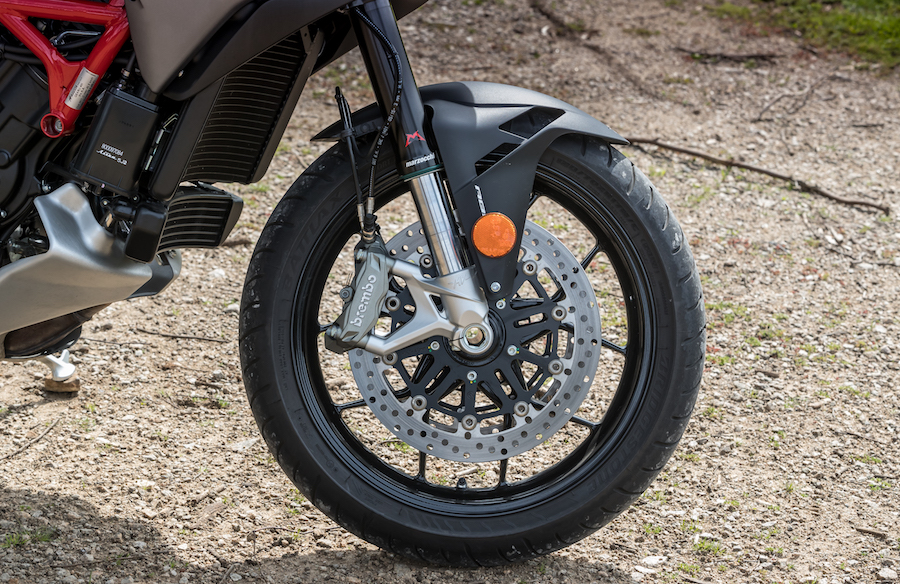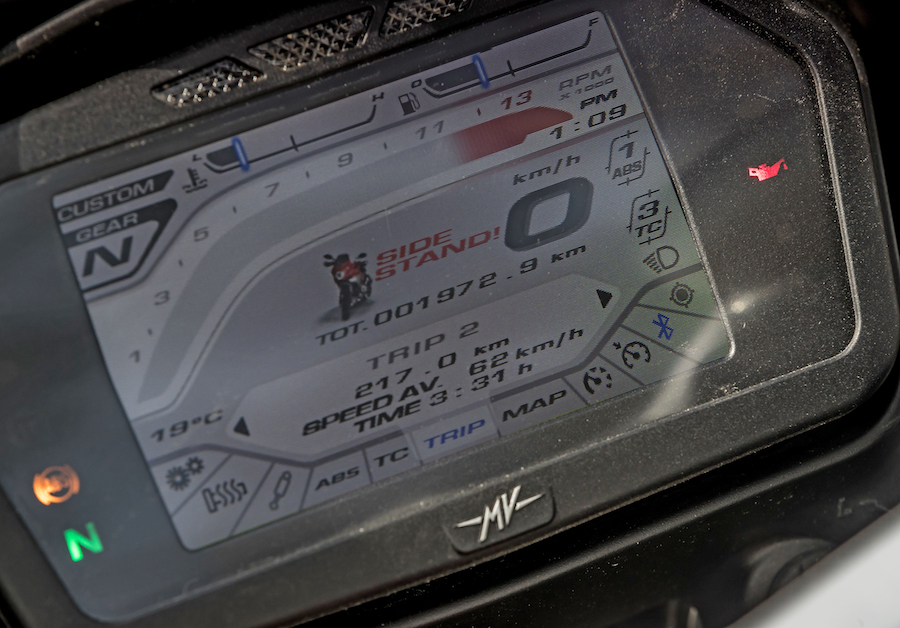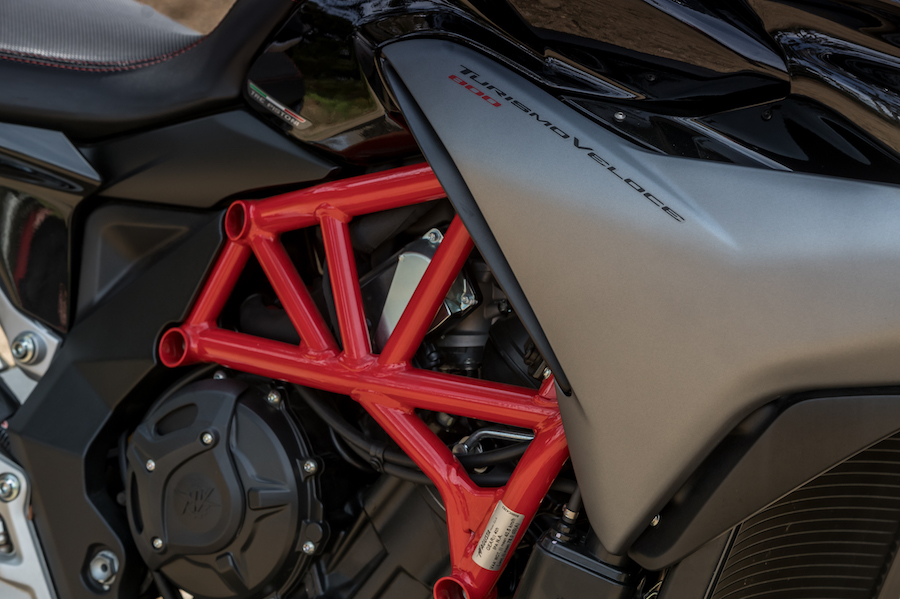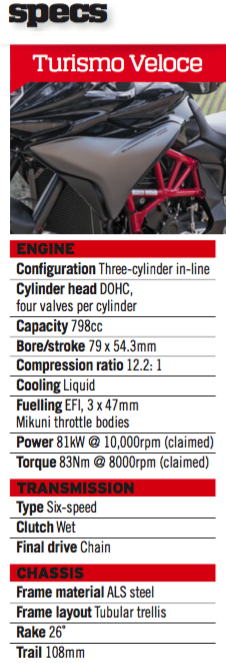Almost three years ago, MV Agusta released its first-ever touring bike. Or did it?
Shit,” I cursed as I checked my mirrors and raised my left arm to let the highway-speed traffic behind me know I was in strife. I was out in the far right lane of a three-lane highway and MV Agusta’s Turismo Veloce was missing and spluttering under acceleration, a bevvy of warning lights on the dash alerting me to something of which I was well and truly aware.
I coasted to the emergency lane and stopped, heart racing, and then I had to laugh. Instead of activating cruise control on the Italian touring bike I’d hopped onto just 10 minutes earlier, I had activated the pitlane speed limiter with its very similar graphic on the bike’s somewhat crowded TFT full-colour five-inch dash.
I took off again, slightly embarrassed, yet secretly loving the fact MV Agusta’s first touring bike comes equipped with a pitlane speed limiter – a delightfully unnecessary nod to the marque’s rich 62-year legacy of racing success. And as I accelerated quickly to merge back among the morning commuters, I realised it can actually be a handy feature on a bike like this, especially in the many highly policed and enforced stretches of roads dotted around this country.
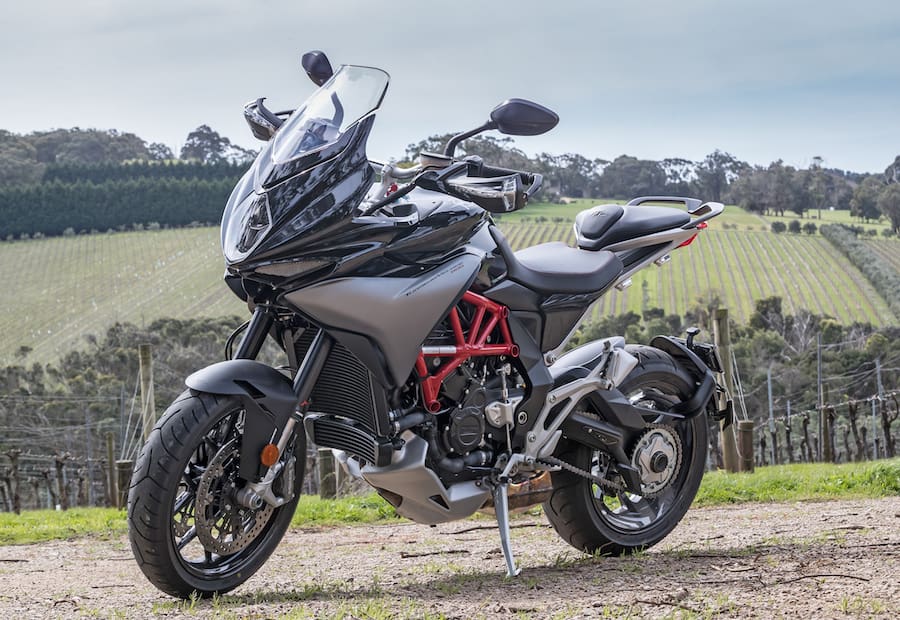
Because of where I live these days, most of my test periods begin with more than an hour of freeway riding that provides a beaut opportunity to get acquainted with a bike before I start asking the hard questions. Mind you, the MV asked a hard question straight up of me, and that’s its 850mm seat height. It’s a long way up, and I certainly am not, but the Turismo Veloce’s waistline is corset-tightened narrow, so once you’ve clambered onto her perch your legs don’t need to go around anything to find their way to the ground. Even for a five-foot-nothing rider like me, there’s plenty of confidence at a standstill.
A thumb of the starter and the recognisable rasp of the Italian-made triple comes alive. The clutch is light – though it matters naught considering how effective the multi-directional quickshifter is – and as I take off I’m reminded of the typical MV Agusta throttle response. The Turismo employs the brand’s MVICS (Motor and Vehicle Integrated Control System) and its ride-by-wire results in one of the lightest-action throttles around. Some have described it as too snatchy, but I really like it.
The upright seating position puts you above every passenger vehicle on the road and, combined with the wide ’bars, it makes picking my way through Melbourne’s morning commuters quite enjoyable.

Once out on the freeway, I’m immediately impressed with the windscreen and the protection it offers, a box every touring bike must tick. It’s a two-position height-adjustable screen with 60mm of variability, and it’s actuated by a clever one-handed doodad so it can be changed on the fly. Importantly, changing the height at highway speeds doesn’t upset the bike and both positions offer an effective windbreak depending on your speed (and height, of course).
As well as the previously mentioned ride-by-wire throttle, or indeed because of it, the MV Agusta has more than enough electronic aids. While there’s no IMU on board – which would facilitate the latest lean-angle-sensitive electrickery like cornering ABS and so forth – the Turismo Veloce boasts switchable ABS, eight levels of traction control (as well as off) and four switchable engine modes: Sport, Touring, Rain and Custom. There’s no electronically adjustable suspension on this version, but its higher-end Lusso sibling offers it.
Melbourne’s wild weather gives me plenty of opportunities to test the different modes in their appropriate environments. And, while I feel I ought to constantly switch as the weather and the conditions change, the wily folk at MV Australia dialled into the Custom setting a mode that they believe showcases the Turismo Veloce at its best. In the end I realise they were exactly right and I leave it in Custom, regardless of the conditions, with the onus back on me to modulate the outcome. Well, not entirely.
The Custom setting unleashes all of the Turismo Veloce’s 81kW of power (in Sport mode), but reduces the severity of the throttle response, which is often half the battle in slippery conditions. Likewise, ABS is set to Level 1 for the least amount of interference, traction control is set to Level 3, just below halfway, and whether I’m splashing around in an inch of water or sailing through warm and dry switchbacks under the sun, the motorcycle itself is so engaging that I am rarely looking for more (or less) in terms of the power, the way it is delivered, or the computer-generated interference out to save my bacon.
For the record, power is reduced to 66kW in Touring mode and reduced even further when Rain mode is activated, down to 58kW. It’s an easy adjustment to make, thumbing the starter button to switch between the modes. All of the other settings and switching (and there’s plenty of them) occurs via the left-hand switchblock and is a simple left and right to toggle through and a direct push to select.
However, I couldn’t get my phone to pair with the Turismo Veloce’s instrument cluster via Bluetooth, despite a couple of attempts. It’s fair to assume it’s the age and condition of my device that prevented it – I could see there were already of couple of previously paired devices showing up on the list, which proves the system works – but it’s probably a good thing anyway. Who wants to be able to read messages and see who’s calling when they’re cruising through the wine country on Victoria’s Mornington Peninsula? Not me…
Certainly not when the revs increase and the jewel in the Turismo Veloce’s crown comes alive. You see, a lot of motorcycles have hugely capable but largely nondescript engines, big lumps of rapidly moving parts designed to propel a two-wheeled vehicle in an effective and efficient manner. Some motorcycles, however, employ engines that are both effective and efficient, yet offer an extra level of engagement to an already charming riding experience. The MV Agusta is one of those motorcycles. Just like the pitlane speed limiter, the 798cc three-cylinder engine is another delightful nod to its racing heritage.
The engine began life in the company’s F3 675 supersport machine, the bike MV Agusta hoped would return it to world championship glory for the first time since Phil Read had won the 500cc title for the Italian marque some 39 years earlier. Entered in the 2013 World Supersport Championship, it scored three podiums in its first year before taking a further seven podiums (including three wins) the following year to finish runner-up to Michael van der Mark on a Honda.
A new crankshaft, an 8.4mm-longer stroke and 30 more mid-range horses (22kW) from an engine that weighed the same as its smaller sibling made the F3 800 a perfect balance between a supersport machine and a superbike, a category that at the time of the 800’s 2013 release was experiencing a decline in popularity.
It was also around this time that the manufacturers began realising that existing platforms could be used to create a swag of different models to cater to different segments of the market – a harsh but certain reality for the likes of MV Agusta, who up until that point produced purely race or race-bred finery.
And so in 2015 MV Agusta unveiled its first touring bike, the MV Agusta Turismo Veloce, powered by a retuned 81kW/80Nm version of that beaut 108kW/88Nm sportsbike engine.

Don’t be fooled by the reduced numbers because its delivery is decorated in mid-range torque, its willingness to spin is fast and free, and its note nothing shy of tre pistoni symphony.
Three years down the road and this new version boasts a couple of updates that ensure the bike – the name of which translates directly as Tour Fast – is the best iteration yet.
Updated switchblocks address ease of everyday use, a tweaked ECU smooths out the delivery to make it slightly less trackday and a little more all day, and the new-for-2017 red frame means you’ll never forget its native Italian lineage.
The Sachs/Marzocchi suspension is sportsbike firm and fully adjustable, and it offers excellent feedback and stability when the scenery begins to blur. I didn’t ride two-up, nor did I have any weight in the panniers when I had the options fitted, but the bike is equipped with quality componentry that leaves zero doubt it would comply equally as well in the fun stuff with a pillion or luggage.
The radial-mounted Brembos are far more capable than the majority of us require, and offer the good feel and plentiful power we’ve come to expect from the brand.
The thing that sticks with me about the Turismo Veloce over every other similar-capacity touring bike around is its width. Both across its front fairing and in its waistline, this MV is significantly narrower than its contemporaries, meaning it is lighter at a standstill, more nimble at speed and less imposing when you’re trying to manhandle the thing into that awkward parking spot at whatever destination you’ve chosen to tour to. This is complemented by knee indentations in the 20-litre tank, which keep it narrow not only when you’re stopped, but when you’re hustling along too. This might not seem much, but when you’re my height and possess my (lack of) strength, it could be the difference between buying a particular bike and overlooking it.
The Turismo Veloce boasts a really handy twin USB outlet below the instruments, adjacent to a pair of not-so-handy compartments moulded into the inner fairing. They might just be big enough to fit a chapstick, or a toll tag, but not a phone or a wallet, or anything else you’d usually carry in your pocket on a motorcycle.
For a touring bike that costs around the same as a kitted-out Triumph Explorer or the Yamaha Super Ténéré, for my money there are some glaring omissions with the MV.
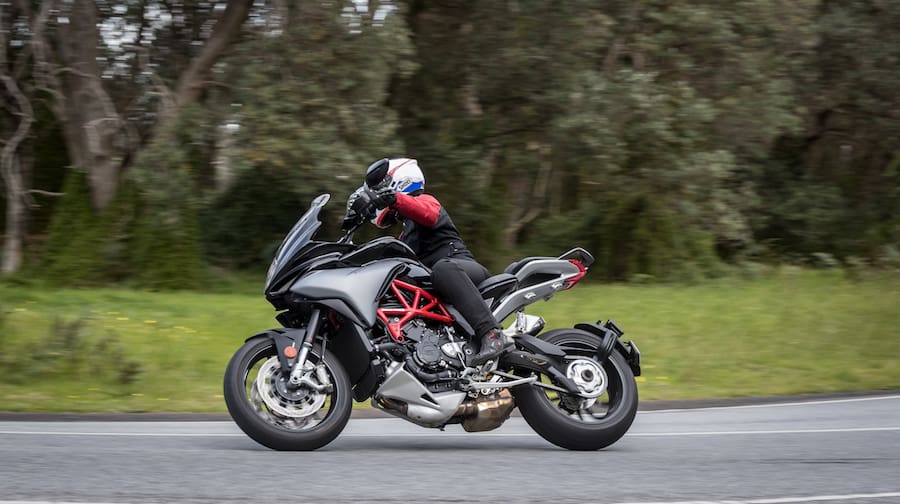
For a start, there’s no centrestand, a minor but handy feature for a touring bike. It’s better to have a motorcycle upright and level when you’re strapping on gear and luggage.
Speaking of luggage, the panniers aren’t standard and cost $2200 – that’s almost 10 per cent of the overall price to turn a so-called touring bike into one with luggage capability.
Finally, there are no heated grips. And the only thing worse than not having heated grips at 5.30 on a sleety Melbourne morning is having a heated-grips graphic on the TFT screen taunting you that if you wanted to enjoy this luxury then you actually needed to cough up another $3500 for the Lusso variant (which has a graphic that isn’t greyed out and whose grips will duly deliver toasty warm goodness).
Aside from those rather insignificant blots on the Turismo Veloce’s copybook (they can all be fixed with aftermarket accessories), there’s a swag of things to love. Not least that it is festooned with typically gorgeous MV Agusta design touches. The triple outlet exhaust exits, the bold hollow design of the tail, the single-sided swingarm, the brash bright-red frame, the way the rear indicators are integrated into the rear hugger… it’s the beauty of owning an MV Agusta and goes a long way to persuading people to part with the couple of grand extra the Italian marque often asks.
That extra money buys you the exotic head-turning ways of a brand that, despite diversifying into different sectors of the marketplace, has staunchly remained true to its rich racing heritage. It’s a few extra bob that buys not just a motorcycle but an engaging experience. I reckon it’s money well spent.
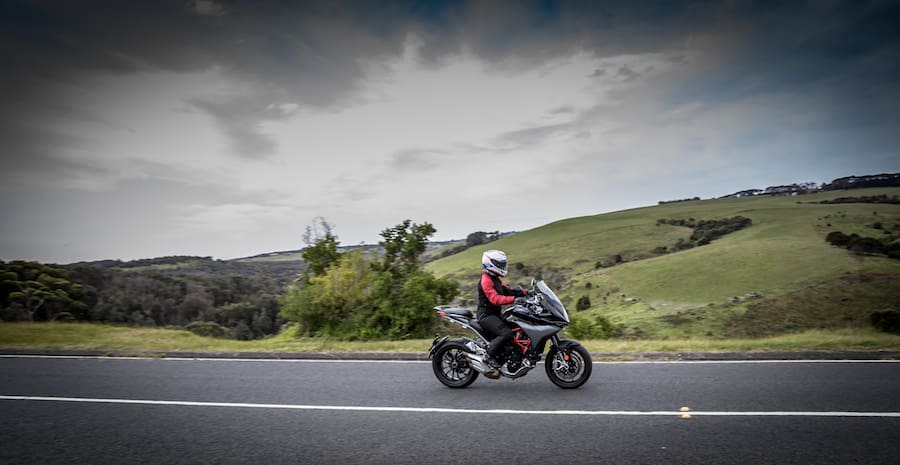
TEST Kel Buckley
PHOTOGRAPHY Mark Dadswell
